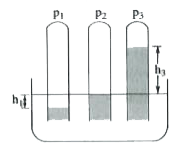Consider gases confined by a liquid, as shown below.
Density of the liquid = d.gmL−1
h1 and h3 in mm and p1,p2 and p3 in mm Hg.

Select correct relation for pressure p3Solution in Telugu
p3=patm+0.1h3d
p3=patm+0.1h3d
p3=patm−h3dg
p3=patm+h3d g
Step by step video & image solution for Consider gases confined by a liquid, as shown below. Density of the liquid = d."gmL"^(-1) h_(1) and h_(3) in mm and p_(1), p_(2) and p_(3) in mm Hg. Select correct relation for pressure p_(3) by Chemistry experts to help you in doubts & scoring excellent marks in Class 12 exams.
Updated on:21/07/2023Topper's Solved these Questions
- STATES OF MATTER BOOK - AAKASH SERIESCHAPTER - STATES OF MATTER EXERCISE - ADDITIONAL PRACTICE EXERCISE- PRACTICE SHEET (ADVANCED) (LINKED COMPREHENSION TYPE QUESTIONS) (PASSAGE- II)
2 Videos
- STATES OF MATTER BOOK - AAKASH SERIESCHAPTER - STATES OF MATTER EXERCISE - ADDITIONAL PRACTICE EXERCISE- PRACTICE SHEET (ADVANCED) (LINKED COMPREHENSION TYPE QUESTIONS) (PASSAGE- III)
3 Videos
- STATES OF MATTER BOOK - AAKASH SERIESCHAPTER - STATES OF MATTER EXERCISE - ADDITIONAL PRACTICE EXERCISE- PRACTICE SHEET (ADVANCED) (MORE THAN ONE CORRECT ANSWER TYPE QUESTIONS)
2 Videos
- SOLUTIONS BOOK - AAKASH SERIESCHAPTER - SOLUTIONS EXERCISE - Objective Exercise -4
50 Videos
- STOICHIOMETRYBOOK - AAKASH SERIESCHAPTER - STOICHIOMETRYEXERCISE - PRACTICE SHEET (ADVANCED) (INTEGER TYPE QUESTION)
2 Videos
Similar Questions
The intermolecular forces operating between two constituent particles depends on the distance between the centres of the molecules. Dipole-dipole interactions are inversely proportional to 3rd power of the distance where as dipole induced dipole interaction are inversely proportional to the sixth power of intermolecular distances.
The forces in dry ice are proportional to (r = intermolecular distance)
View SolutionDensity of gas is inversely proportional to absolute temperature and directly proportional to pressure
⇒d∝PT⇒dTP = constant ⇒d1T1P1=d2T2P2
Density at a particular temperature and pressure can be calculated bousing ideal gas equation
PV=nRT⇒PV=massmolar mass (M)xRT
P×M=massvolume×RT⇒P×M=d×RT
d=PMRT
Which of the following has maximum density?
View SolutionWhich of the following graphs give a straight lines for the given properties of an ideal gas
View SolutionAssertion : Molarity of a solution decreases with an increase of temperature
Reason : As temperature increases volume of the solution increases.
View SolutionAmmonia is oxised by oxygen to give nitric oxide and water. The weight of water produced per gram of nitric oxide is 0.1×xg. What is value of d.
View SolutionLet p_(1),p_(2),p_(3) be primes with p_(2)!=p_(3), such that 4+p_(1)p_(2) and 4+p_(1)p_(3) are perfect squares.Find all possible values of p_(1),p_(2),p_(3)
View SolutionIf P_(atm) = 0 mm Hg and P_(alv) = -2 mm Hg, then
View SolutionTotal vapour pressure of mixture of 1 mole of volatile component A (P_(A)^(@)=100 mm Hg) and 3 mole of volatile component B (P_(B)^(@)=80 mm Hg) is 90 mm Hg . For such case :
View SolutionA mixture contains 1 mole of volatile liquid A (P_(A)^(@) =100mm Hg) and 3 moles of volatile liquid B (P_(B)^(@) =80 mm Hg). If solution behaves ideally, the total vapour pressure of the distillate is :
View SolutionTotal vapour pressure of mixture of 1 mol of volatile component A(p∘A=100mm Hg) and 3 mol of volatile component B(p∘B=60 mm Hg) is 75 mm. For such case:
View Solution|underset("("p_(1)")")(H_(2))|underset("("p_(1)")")(H^(+))|underset("("1M")")(H^(+))|underset("("p_(2)")")(H_(2))| Pt (where p_(1) and p_(2) are pressures) cell reactioin will be spontaneous if:
View SolutionThe top surface of an incompressible liquid is open to the atmosphere. The pressure at a depth h1 below the surface is p1 . What is the pressure p2 at depth h2=2h1 compare with p1 ?
View SolutionIf p1,p2,p3 are altitudes of a ΔABC then show that
1p1+1p2+1p3=1r
View SolutionIf p1,p2,p3 are altitudes of a ΔABC then show that
1p1+1p2+1p3=1r
View SolutionThe ratio of density of 3 kinds of petrol P1,P2 and P3 is 9:7:5. The density of P1 is 18 gm/ cc and P1,P2,P3d are mixed in the ratio of 6:5:4 by weight. If a litre of P3 cost Rs. 40, then find the cost of P3 in 450 kg of mixture of P1,P2 and P3
View Solution
